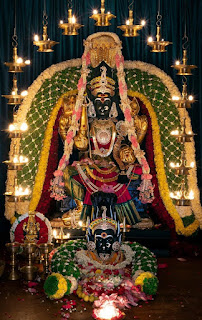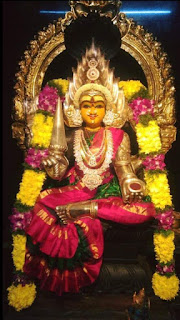आत्म-विद्या (583)
Ātma-vidyā
Since She imparts knowledge (vidyā) of the Supreme Ātman, she is addressed as Ātma-vidyā.
महा-विद्या (584)
Mahā-vidyā
The process of Self-realization and attainment of true knowledge is known as mahā vidyā .
श्री-विद्या (585)
Śrī-vidyā
Śrī-vidyā is Pañcadaśī mantra. Pañcadaśī and ṣodaśī mantra-s are considered as most secretive. These mantra-s, if properly initiated and recited as per the prescribed rules, one is bound to attain liberation.
कामसेविता (586)
Kāmasevitā
Kāma means the lord of love, Manmatha. She is worshipped by Manmatha.
श्री-षोडशाक्षरी-विद्या (587)
Śrī-ṣoḍaśākṣarī-vidyā
Soḍaśī mantra is superior to Pañcadaśī.
ṣoḍaśī mantra is meant exclusively for liberation and those who seek liberation alone should be initiated in this mantra. ṣoḍaśī mantra is the ultimate of all mantra-s and there is no other mantra superior to this. She's in the form of the most powerful and superior mantra.
त्रिकूटा (588)
Trikūṭā
She is in the form of triads. In spirituality there are a number of triads. OM consists of three letters a + u + m. In Gāyatrī mantra three worlds are mentioned bhūr, bhuva and suvaḥ. Gods of creation, sustenance and death are known as Brahma, Viṣṇu and Rudra. Three stages of consciousness awake, dream and deep sleep. Three guṇa-s sattva, rajas and tamas. Three stages of time past, present and future. Pañcadaśī mantra consists of three kūṭa-s agni, surya and candra. icchā śakti, jñāna śakti and kriyā śakti-s. Triads are associated only with Her.
कामकोटिका (589)
Kāmakoṭikā
Śiva-Śaktī aikya happens in two forms. One is Śaktī sitting on the lap of Śiva and another is Ardhanārīśvara form, where one vertical form is Śiva and another is Śaktī. This is referred to in this nāma. Kāma refers to Śiva and koṭi means vertical.
कटाक्ष-किङ्करी-भूत-कमला-कोटि-सेविता(590)
Kaṭākṣa-kiṅkarī-bhūta-kamalā-koṭi-sevitā
By Her mere glance She is attended by millions of Lakṣmī-s, the Goddess of wealth. If Lakṣmī glances at a person his richness grows. This nāma says that Lalitāmbikā is attended to by countless number of Lakṣmī-s, signifying Her incomprehensible nature of wealth and prosperity.
शिरःस्थिता (591)
Śiraḥsthitā
She is in the head. Head means the sahasrāra at the top of the head.
चन्द्र-निभा (592)
Candra-nibhā
The shine of the moon is visualized just below sahasrāra. The visibility of moon is a strong indication to know the progress achieved in kuṇḍalinī meditation. The third kūṭa of Pañcadaśī mantra is candra kūṭa. She is like this moon.
भालस्था (593)
Bhālasthā
She is in the form of the bindu of bīja hrīṁ in ājñā cakra. She resides in ājñā cakra in the forehead.
इन्द्र-धनुः-प्रभा (594)
Indra-dhanuḥ-prabhā
Indra dhanu in literal sense is Indra’s bow. But, in this context it indicates rainbow. There is a rainbow just above the bindu of hrīṁ (ह्रीँ) . The bindu itself shines. Apart from bindu, this rainbow like structure that is quarter of the size of the bindu also shines. The bindu and rainbow like formation which is also known as ardhacandra (half the shape of the moon thereby forming a rainbow), get exploded at sahasrara.
हृदयस्था (595)
Hrdayasthā
She resides in the heart.
रविप्रख्या (596)
Raviprakhyā
She shines like the sun, residing in one’s heart.
त्रिकोणान्तर-दीपिका (597)
Trikoṇāntara-dīpikā
She shines like a flame in the triangle of mūlādhāra cakra.
दाक्षायणी (598)
Dākṣāyaṇī
She was born to Dakṣa and got married to Śiva. This nāma talks about Her lineage.
दैत्य-हन्त्री (599)
Daitya-hantri
Daitya means evil and represented as demons in epics. She is the slayer of all evil acts (demonic qualities).
दक्ष-यज्ञ-विनाशिनी (600)
Dakṣa-yajña-vināśinī
There existed two Dakṣa-s. One is known as Dakṣa Prajā-pati, a superhuman character and another is the human incarnation of the former. They did not respect Śiva. Sakthi was behind the destruction of the yagnas that were performed by them.
दरान्दोलित-दीर्घाक्षी (601)
Darāndolita-dīrghākṣī
She has shapely eyes that almost touch Her ears. Her eyes rotate all-round to dispel the fear of Her devotees.
दरहासोज्ज्वलन्-मुखी (602)
Darahāsojjvalan-mukhī
This nāma describes Her smile. This smile attracts everyone to become Her devotee.
गुरुमूर्तिः (603)
Gurumūrtiḥ
She is in the form of Guru.
गुणनिधिः (604)
Guṇanidhiḥ
She is the storehouse of guṇa-s.
गोमाता (605)
Gomātā
She is the Mother of all cows. Cows are considered sacred.
गुहजन्म-भूः (606)
Guhajanma-bhūḥ
Guha means Kārthikeya, also known as Subrahmaṇya and Skanda. This nāma also could mean that She had given birth to Kārttikeya.
देवेशी (607)
Deveśī
She is the Īśvarī for Deva-s (gods), which means that She is the Supreme among all gods and goddesses. She is the source for all divinities.
दण्ड-नीतिस्था (608)
Daṇḍa-nītisthā
Daṇḍa-nīti means encumbering those who resort to evil ways and making them to pursue the path of goodness. She punishes those ignorant men who are unwilling to pursue the virtuous path.
दहराकाश-रूपिणी (609)
Daharākāśa-rūpiṇī
In the hearts of all beings is Her subtle form.
प्रतिपन्-मुख्य-राकान्त-तिथि-मण्डल-पूजिता (610)
Pratipan-mukhya-rākānta-tithi-maṇḍala-pujitā
Pratipad means the first lunar day and rākā means the full moon. In Śrī Cakra, She is surrounded by fifteen tithi nitya devi-s, five on each side of the inner most triangle. The bindu, the central point of Śrī Cakra, where Śaktī is sitting on the lap of Śiva is covered by this inner most triangle. Each of the lunar day is represented by one tithi nitya devi. She's worshiped daily starting with pratipad and ending with full moon.
कलात्मिका (611)
Kalātmikā
There are four stages of consciousness. They are awake, dream, deep sleep and turya stages. Each of these stages has four kalā-s making a total of sixteen kalā-s. The awake stage is said to be in the form Lalitāmbikā. The four kalā-s of awake stages are rising, waking, consciousness and mental action.
कलानाथा (612)
Kalānāthā
She is ruler of kalā-s discussed above. All subtle matters that make a gross matter are administered by Her. Hence, She is known as the ruler of kalā-s.
काव्यालाप-विनोदिनी (613)
Kāvyālāpa-vinodinī
It is said that by properly worshipping Her, one attains poetization capabilities. She is in the form of great poetic epics.
सचामर-रमा-वाणी-सव्यदक्षिण-सेविता (614)
Sacāmara-ramā-vāṇī-savyadakṣiṇa-sevitā
Goddess Lakṣmī (Ramā) and Goddess Sarasvatī (Vāṇī) stand by Her side and fan Her. This nāma means that those who contemplate Her get wealth and intelligence without even asking for them.
आदिशक्तिः (615)
Ādiśaktiḥ
She is the primordial energy of creation.
अमेया (616)
Ameyā
She is immeasurable. Mortals are measureable and eternal is not measureable.
आत्मा (617)
Ātmā
She's the Self (Atma).
परमा (618)
Paramā
She's the Supreme.
पावनाकृतिः (619)
Pāvanākṛitiḥ
She is the embodiment of purity.
अनेक-कोटि-ब्रह्माण्ड-जननी (620)
Aneka-koṭi-brahmāṇḍa-jananī
She has given birth to billions of worlds .
दिव्य-विग्रहा (621)
Divya-vigrahā
She has a divinely shaped body.
क्लींकारी (622)
Klīṁkārī
She is in the form of kāma bīja klīṁ (क्लीं). It is also known as Manmatha (Kāmadeva) bīja, the bīja of the love god.
Klīṁkāra is Śiva and his wife is Klīṁkārī and this way Ka means Śiva and la means Śaktī and īṁ (ईं) is kāmakalā (nāma 322). Therefore klīṁ also means Śiva-Śaktī union.
केवला (623)
Kevalā
She is The Absolute.
गुह्या (624)
Guhyā
She is secretive both in form and in nature. It is repeatedly said that Her worship should be of secretive in nature. She cannot be worshipped in the presence of those who do not have fundamental knowledge about Her.
Navāvaraṇa pūja should not be performed in the presence of those who are not initiated into Her mantra-s. The secrecy in Her worship is advocated because She provides certain superhuman powers to the worshipper, provided the ritual is performed without any deviations.
कैवल्यपद-दायिनी (625)
Kaivalyapada-dāyinī
Kaivalya is the final stage of life of a living being. Nobody is there with that being during that time. He is all alone without any help around and he has to achieve on his own. This is the final stage of one’s evolution. The soul is about to leave its present body and getting ready to merge with the Brahman. Kaivalya is liberation or salvation and hence it is called the final stage. Lalitāmbikā is the giver of this stage.
















No comments:
Post a Comment